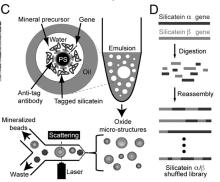


In the not-too-distant future, scientists may be able to use DNA to grow their own specialized materials, thanks to the concept of directed evolution. UC Santa Barbara scientists have, for the first time, used genetic engineering and molecular evolution to develop the enzymatic synthesis of a semiconductor.
"In the realm of human technologies it would be a new method, but it's an ancient approach in nature," said Lukmaan Bawazer, first author of the paper, "Evolutionary selection of enzymatically synthesized semiconductors from biomimetic mineralization vesicles," published in the Proceedings of the National Academy of Sciences. Bawazer, who was a Ph.D. student at the time, wrote the paper with co-authors at UCSB's Interdepartmental Graduate Program in Biomolecular Science and Engineering; Institute for Collaborative Biotechnologies; California NanoSystems Institute and Materials Research Laboratory; and Department of Molecular, Cellular and Developmental Biology. Daniel Morse, UCSB professor emeritus of biochemistry of molecular genetics, directed the research.
Using silicateins, proteins responsible for the formation of silica skeletons in marine sponges, the researchers were able to generate new mineral architectures by directing the evolution of these enzymes. Silicateins, which are genetically encoded, serve as templates for the silica skeletons and control their mineralization, thus participating in similar types of processes by which animal and human bones are formed. Silica, also known as silicon dioxide, is the primary material in most commercially manufactured semiconductors.
In this study, polystyrene microbeads coated with specific silicateins were put through a mineralization reaction by incubating the beads in a water-in-oil emulsion that contained chemical precursors for mineralization: metals of either silicon or titanium dissolved in the oil or water phase of the emulsion. As the silicateins reacted with the dissolved metals, they precipitated them, integrating the metals into the resulting structure and forming nanoparticles of silicon dioxide or titanium dioxide.
With the creation of a silicatein gene pool, through what Bawazer only somewhat euphemistically calls "molecular sex" –– the combination and recombination of various silicatein genetic materials –– the scientists were able to create a multitude of silicateins, and then select for the ones with desired properties.
"This genetic population was exposed to two environmental pressures that shaped the selected minerals: The silicateins needed to make (that is, mineralize) materials directly on the surface of the beads, and then the mineral structures needed to be amenable to physical disruption to expose the encoding genes," said Bawazer. The beads that exhibited mineralization were sorted from the ones that didn't, and then fractured to release the genetic information they contained, which could either be studied, or evolved further.
The process yielded forms of silicatein not available in nature, that behaved differently in the formation of mineral structures. For example, some silicateins self-assembled into sheets and made dispersed mineral nanoparticles, as opposed to more typical agglomerated particles formed by natural silicateins. In some cases, crystalline materials were also formed, demonstrating a crystal-forming ability that was acquired through directed evolution, said Bawazer.
Because silicateins are enzymes, said Bawazer, with relatively long amino acid chains that can fold into precise shapes, there is the potential for more functionality than would be possible using shorter biopolymers or more traditional synthetic approaches. In addition, the process could potentially work with a variety of metals, to evolve different types of materials. By changing the laboratory-controlled environments in which directed evolution occurs, it will be possible to evolve materials with specific capacities, like high performance in an evolved solar cell, for example.
"Here we've demonstrated the evolution of material structure; I'd like to take it a step further and evolve material performance in a functional device," said Bawazer.
Research for this paper was supported by the U.S. Department of Energy.
† Bottom image:
( C ) Polystyrene microbeads coated with silicatein ? [by in vitro compartmentalization] are reacted with small metal-containing precursors in water-in-oil emulsions, yielding mineral composites…which are then isolated from nomineralized polymer beads by flow sorting, with light scattering used to identify large beads for sorting. (D) Schematic summary of the gene library used for evolutionary selection experiments. Recombinant genes for two natural isoforms of silicatein were digested and reassembled by DNA shuffling to produce a chimeric library of variant silicateins, which were then screened to identify previously undescribed mineralizing variants via the process summarized in C. Published with permission from:
PNAS Plus - Biological Sciences - Biochemistry:
Lukmaan A. Bawazer, Michi Izumi, Dmitriy Kolodin, James R. Neilson, Birgit Schwenzer, and Daniel E. Morse
PNAS Plus: Evolutionary selection of enzymatically synthesized semiconductors from biomimetic mineralization vesicles
PNAS 2012 ; published ahead of print June 7, 2012,
doi:10.1073/pnas.1116958109



